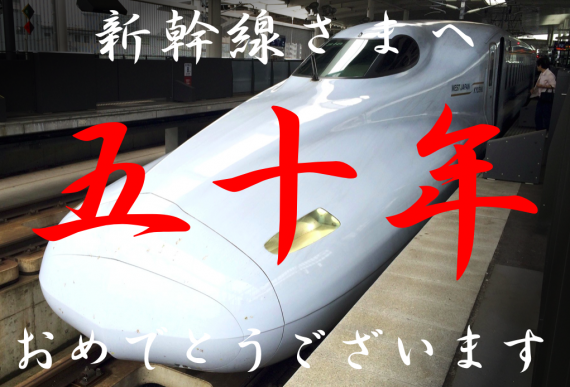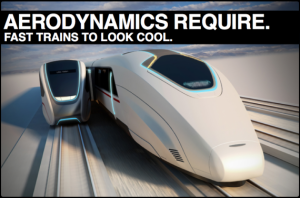On October 1, 1964 the inaugural Shinkansen Bullet Train service on the Tokaido Line began rocketing citizens between Tokyo and Osaka at speeds up to 130 mph, and a beautiful and wholly unequaled machine quickly became the pride of a nation.
• • •
[MIRRORING VIA AKIHABARANEWS.COM BECAUSE WE CAN]
新幹線
しんかんせん
“Shin kan sen”
It’s time to celebrate the 50th anniversary of one of
Japan’s most iconic technological achievements:
The world’s first modern high-speed rail system!
Shinkansen Begins
On October 1, 1964 the inaugural Shinkansen Bullet Train service on the Tokaido Line began rocketing citizens between Tokyo and Osaka at speeds up to 130 mph. It was Japan’s bold statement that they had rebuilt, and on a global stage were charging ahead as a peaceful, modern, technologically innovative nation. The project had its fair share of early controversy and cost overruns, to be sure, but as was hoped and intended, the beautiful and wholly unequaled machine quickly became the pride of a nation.
From the very beginning, the futuristic-looking trains have been the stars. The very first were designated the 0-Series, the service was the Hikari Shinkansen, and with their airplane-like shape they were the embodiment of 1960’s sci-fi sleek. The 0-Series proved so functional and popular that variations and updates on the original design remained in operation until 2008.
Sure, there’d been plenty of high-speed prototype and demonstration trains before, but the Shinkansen were not a one-off test case: these trains were the vehicles of the world’s first dedicated, systematized high-speed passenger rail service.

0-Series ‘Hikari’ Shinkansen; 1967 (Wikipedia)

0-Series ‘Hikari’ Shinkansen interior; 1967 (Wikipedia)
To the Now
In the 50 continuous years of service since, the Tokaido Line alone has transported more than 5.3 billion passengers – yes, with a B – and it remains far and away the busiest passenger rail corridor in the world. As a whole, the Shinkansen network has transported the equivalent of earth’s current population of ~7 billion, plus another three…billion. Just for fun perspective, that number is equal to just slightly under 10% of all humans who’ve ever lived. And they’ve traveled in great comfort – to quote ourselves:
“Even the oldest, cheapest Shinkansen seat is like airline first-class…but better, because you can get up and walk around anytime. To the vending machines. To the spacious, modern bathrooms. Maybe even the smoking room. Or like, just because you want to walk. Most trains have electrical outlets. They’re super clean. Most have 3G wireless; some have wi-fi. There’s a roving food card selling souvenirs and boxed lunches and juice and beer and tea and coffee. A nice little hook for your jacket. No ridiculous security checks. Approximately 160-180 MPH (270-290 KPH). And, they’re renowned for being aggressively on-time.”
With 5 primary lines spanning most of the country and continually expanding (very soon to be 7), Japan’s high-speed rail network now covers some 2,700 km (1,700 mi), with 90% of the lines rated for speeds of 240-320 km/h (150-200 mph). The network offers 17 distinct services between various locations along the main lines, and while it is not the world’s largest, it is widely regarded as the overall fastest, safest, and most technologically advanced system.

Japan Railways East Shinkansen Lineup; 2012 (Wikipedia)
About 20 different train models have been commercially operated since 1964’s 0-Series Hikari, and several more are currently in testing and development. Iterative upgrades aside, the two most exciting Shinkansen projects are the Free Gauge Train (FGT), which is able to vary the width and orientation of ifs stance in order to operate on both Shinkansen and traditional gauge rails, and the various models currently testing for what will become the maglev-driven Chuo Shinkansen line, including the MLX01 series, and the newest, the L0 (L-zero) Shinkansen. The Free Gauge Train will undergo another 2.5 years of testing before (most likely) entering service in Kyushu, while the next-gen maglev trains probably won’t see everyday passengers until the mid- to late-2020s, but when passengers finally do get aboard, they will be transported at speeds in excess of 500 kph (310 mph).

Kyushu Railways Free Gauge Train (FGT); Asahi Shimbun 2014

The L0 (L-Zero) Maglev; Wikipedia 2013
The minds and companies behind the modern Shinkansen continue advancing their development, and as we and others have increasingly reported, over the past year and a half Japan has been eager to not only improve domestic service but also export the technology beyond eastern Asia. Suffice it to say, there are no signs of a pun-intended slow down.
Essential Context
The establishment and wild success of the Shinkansen high-speed rail service would undeniably be a profound technological milestone for any nation under any circumstances. As such, it is amazing that after a crushingly humbling, devastating World War II defeat, less than 20 years later Japan successfully deployed what was then and remains now the world’s most advanced passenger rail system. Moreover, 10 days after the October 1 Shinkansen debut, Japan also opened the widely successful and considerably tech-for-their-time 1964 Tokyo Summer Olympics. The transformation, the achievements…are truly astounding – and inspiring.
On that day 50 years ago, when commercial Shinkansen services first rolled out of Tokyo, Japan proudly declared a technology standard that remains unchallenged to this day. What went unsaid and remains somewhat unsung was the much more humble, subtextual statement about the work ethic, perseverance, and overall character of a nation.
And so, with the multimedia celebration that follows, Happy 50th to the Shinkansen!


Kumamoto Shinkansen Station on a very quiet day: main entrance

Kumamoto Shinkansen Station on a very quiet day: staging area, platforms are directly above






[THIS ARTICLE ORIGINALLY APPEARED AT AKIHABARANEWS.COM]
• • •
Who wants to buy a dorky t-shirt?
↓








